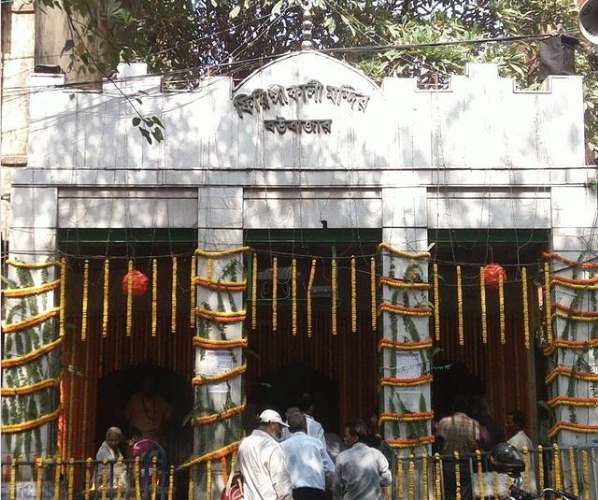Firingi Kalibari is a 500-year-old Goddess Kali temple located on Bipin Bihari Ganguly Street in Kolkata’s Bowbazar neighborhood. The temple is named after Anthony Firingee, a Portuguese, who converted to Hinduism and was a great devotee of Kali.

Even though Anthony had been a Christian by birth, he worshipped Goddess Kali. Anthony Firingi installed the idol of Siddheswari Kali inside the temple, which was originally a Shiva temple.
At this temple, the Portuguese Kabiyal, Anthony, delighted the crowd by singing devotional songs while submitting himself to the Goddess.
Who was Anthony Firingee?
Born Hensman Anthony, he came to Bengal sometime in the early 19th century and settled in Farashdanga( (the old name of Chandannagar). Firingi was a colloquial term for people of foreign origin in Bengal at the time.
Anthony did not just learn the language of Bengal, he also was drawn to the culture and religion of the land, so much so, that he even learned the art of Kabigaan from Bhola Moira.
He quickly gained recognition as a Kabial, literary face-off, wherein folk poets sing and perform.
From Chandannagar, Anthony traveled to Kolkata. His maternal uncle’s house was near to the temple. Antony became a devotee of Goddess Kali and pen down numerous devotional songs on Goddess Kali in the early 19th century.
It was a remarkable event at the time. A Christian foreigner was breaking all barriers and shackles of religion and was worshipping a Hindu Goddess and practicing Hindu rituals.
He fell in love with a Hindu Brahmin widow and married her. His wife, Saudamini Devi, was later burned to death for being a widow and remarrying Anthony, a foreigner.
About Firingi Kalibari
Firingi Kalibari temple is surrounded by North Kolkata’s old-world charm. It is in a busy and congested part of the city. The temple’s modest structure stands over the main road. The temple’s name is carved in metal, and the exterior walls are made of marble. There are three entrances to the temple that lead to the main sanctum.
Many believe that the primary deity of the temple, Siddheshwari Kali, grants ‘siddhi’ or salvation to the people and can fulfill all wishes. Both residents and visitors reverently adore the deity.
You will also find Goddesses Sitala and Manasa and a Ashthadhatu Durga, inside the temple. .
Although Firingi Kali Bari’s sanctum sanctorum is small, it exudes tranquillity and peace within its four walls. Inside the temple, there is very little space to stand and worship. Most people pay respect and worship from the outside.
Outside the temple, there are several stalls selling items needed for puja. The temple is open to devotees from 6 a.m. to 8 p.m. seven days a week. On Tuesdays and Saturdays, which are considered auspicious days to worship Goddess Kali, a large number of devotees visit the temple.
The puja is performed by temple priests. The temple as a whole is well-kept and clean. Despite its location on the main road, the temple exudes calm as soon as one enters and prays to the Goddess.
History of Firingi Kalibari
Like many other ancient temples, the temple’s exact recorded history is disputed. A plaque on the temple dates it to 905 Bengali Year or around 1498 AD. This proves that the temple was built far earlier than the arrival of the Europeans in Bengal. So, it is clear that Anthony Firingee did not build the temple. Then, who constructed this ancient temple.
As per Sir Harry Evan Cotton’s Calcutta Old and New, a descriptive handbook of the city, the temple was established by one Srimanta Dom. Since ‘Dom’ was considered to be a very low caste mainly associated with the cremation of bodies, his temple did not have any priest, and he used to perform the duties of a priest himself.
He also used to treat people suffering from smallpox and used to worship an idol of Goddess Sitala. Sitala is a folk deity, worshiped in the Bengal region, and believed to cure diseases like poxes, sores, ghouls, and pustules.
Those days, many foreigners(firingi) from the vicinity, used to visit the temple for treatment. Many believe that from this event, the temple got the name Firingi Kali Bari
Another legend states the temple to be originally a Shiva Temple, where the idol of Siddheswari Kali was established later by Anthony Firingi.
Today also, if you visit the temple, you will find that under the main dome of the temple, there is a Shivalinga and the idol of Kali is quite far from it.
Originally, the Maa Kali idol was made of clay. During the 1946 riots, the old clay idol was destroyed. In 1987, a concrete idol was created. Animal sacrifice was once practised. It no longer occurs.
The life of Anthony Firingee on big screen
Antony Firingee’s life and times were immortalized on film in a black-and-white film released in 1967. Mahanayak Uttam Kumar portrayed the ardent European Kabiyal. Jaatishwar, a 2014 adaptation directed by Srijit Mukherji, depicted Anthony’s life in retrospect but with a modern-day context.
In his book Kabiyal Anthony Firingee, Madan Bandopadhay makes the first mention of Anthony Firingee.
How to reach
The nearest metro station is CentrAL, and the closest bus stop on Chittaranjan Avenue is Bowbazar.


